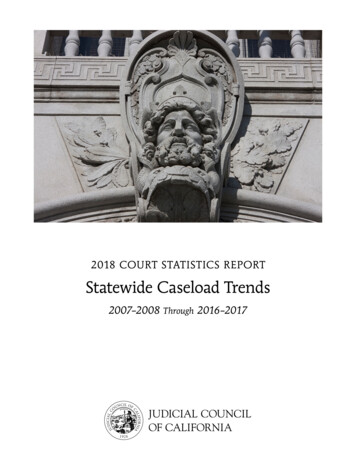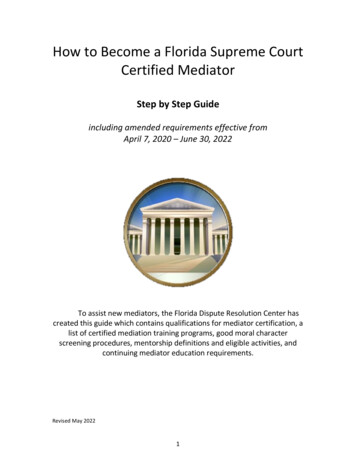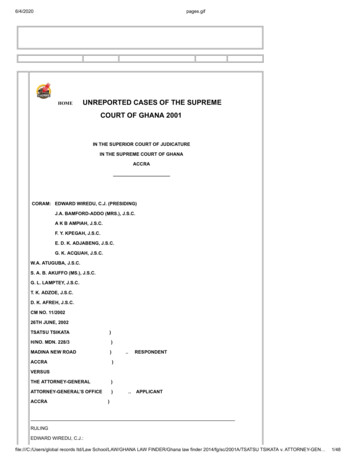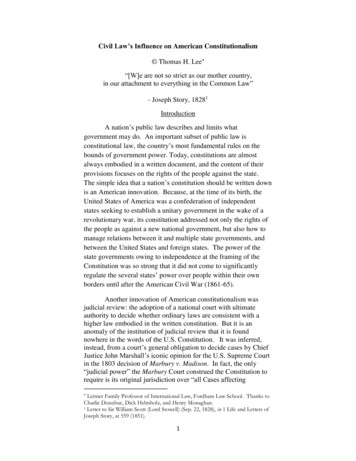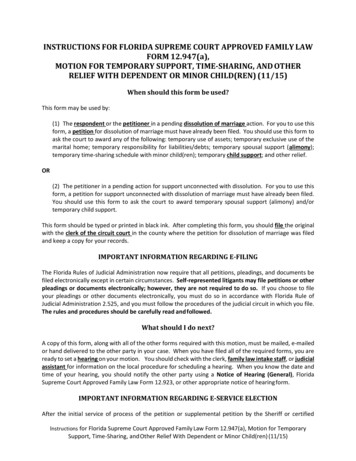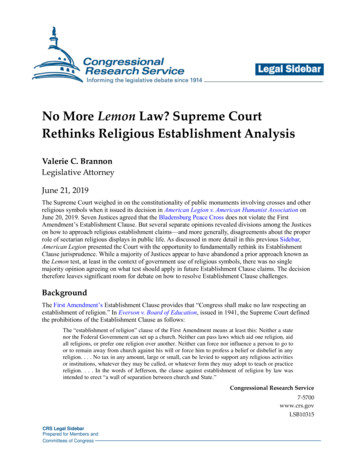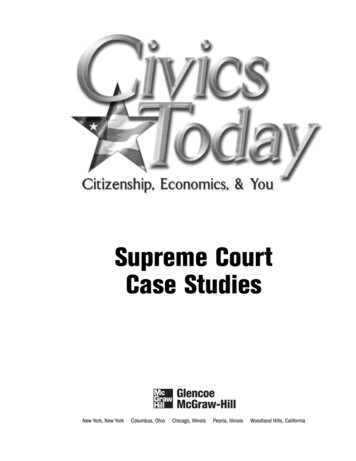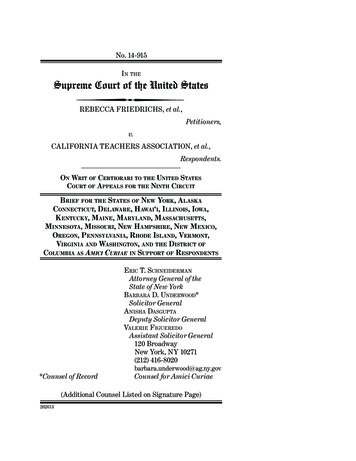
Transcription
No. 14-915In theSupreme Court of the United StatesRebecca Friedrichs, et al.,Petitioners,v.California Teachers Association, et al.,Respondents.On Writ of Certiorari to the United StatesCourt of A ppeals for the Ninth CircuitBrief for the States of New York, A laskaConnecticut, Delaware, Hawai‘i, Illinois, Iowa,K entucky, Maine, Maryland, Massachusetts,Minnesota, Missouri, New Hampshire, New Mexico,Oregon, Pennsylvania, Rhode Island, Vermont,Virginia and Washington, and the District ofColumbia as Amici Curiae in Support of RespondentsEric T. SchneidermanAttorney General of theState of New YorkBarbara D. Underwood*Solicitor GeneralA nisha DasguptaDeputy Solicitor GeneralValerie FigueredoAssistant Solicitor General120 BroadwayNew York, NY 10271(212) 416-8020*Counsel of Recordbarbara.underwood@ag.ny.govCounsel for Amici Curiae(Additional Counsel Listed on Signature Page)262613
QUESTION PRESENTEDIn Abood v. Detroit Board of Education, 431 U.S.209 (1977), this Court confirmed that theConstitution permits States to adopt the model ofcollective bargaining that is widely used in theprivate sector pursuant to federal labor law. Underthis model, a union that employees select to serve ng negotiations may charge all representedemployees––including those who decline to join theunion––an “agency fee” to defray the costs of mployees. In reliance on Abood, twenty-three Statesand the District of Columbia have long authorizedpublic-sector collective-bargaining arrangements thatinclude agency-fee provisions.Amici States address the following questionraised by petitioners:Whether Abood should be overruled, therebyforcing States to abandon collective-bargainingarrangements utilizing agency-fee rules, whichmany States have long used to ensure laborpeace and guarantee the efficient anduninterrupted provision of government servicesto the public?
iiTABLE OF CONTENTSPageINTEREST OF THE AMICI STATES . 1STATEMENT OF THE CASE . 3A. This Court’s Long-Standing Recognitionthat Agency Fees May Be Imposed toFund Private-Sector CollectiveBargaining Activities . 3B. The Court’s Holding in Abood ThatStates May Use ExclusiveRepresentation and Agency Fees toManage Labor Relations with Stateand Local Government Employees . 5C. Abood’s Centrality to Public-SectorLabor Relations Nationwide . 7D. Petitioners’ Challenge to California’sAgency-Fee Provisions for State PublicSchool Teachers . 8SUMMARY OF ARGUMENT . 9ARGUMENT . 11THE STATES HAVE A SIGNIFICANT ANDVALID INTEREST IN PRESERVING ABOOD . 11I.Agency Fees Are Important to Maintainingthe Collective-Bargaining Model That ManyStates Rely Upon to Ensure the Effectiveand Efficient Provision of Services to thePublic . 13
iiiA. State Laws Governing Public-SectorCollective Bargaining Were Adopted inResponse to Devastating Strikes andLabor Unrest by State and LocalEmployees. . 13B. In Responding to These Crises, StatesNaturally Looked to the CollectiveBargaining Model That Had AlreadyProven Effective in the Private Sectorunder Federal Labor Law. . 20C. The Benefits to States of Public-SectorCollective Bargaining Extend WellBeyond the Prevention of Strikes . 251. Public-sector collective bargainingcan promote greater efficiency in thedelivery of public services . 252. Petitioners’ amici misrepresent therole of collective bargaining inmunicipal bankruptcies. . 28II. The Variation in Public-Sector CollectiveBargaining Laws Does Not UndermineAbood, but Rather Confirms the Validityof Its Flexible Framework. . 30III. The First Amendment Does Not ProhibitStates from Borrowing Effective andWidely Accepted Private-Sector CollectiveBargaining Models to Regulate PublicSector Labor Relations. . 34CONCLUSION . 37
ivTABLE OF AUTHORITIESCasesPage(s)Abood v. Detroit Board of Education, 431 U.S.209 (1977) . passimAllied-Signal, Inc. v. Director, Division ofTaxation, 504 U.S. 768 (1992) . 11Association of Surrogates & Supreme CourtReporters v. State, 78 N.Y.2d 143 (1991) . 16Brotherhood of Railway & Steamship Clerks v.Allen, 373 U.S. 113 (1963) . 5Burlington Northern Railroad Co. v.Brotherhood of Maintenance of WayEmployees, 481 U.S. 429 (1987) . 3Bush v. Vera, 517 U.S. 952 (1996) . 11Communications Workers of America v. Beck,487 U.S. 735 (1988) . 4Connick v. Myers, 511 U.S. 138 (1983) . 35,36DiMaggio v. Brown, 19 N.Y.2d 283 (1967) . 16Ellis v. Brotherhood of Railway, Airline &Steamship Clerks, 466 U.S. 435 (1984) . 24Engquist v. Oregon Department of Agriculture,553 U.S. 591 (2008) . 34First National Maintenance Corp. v. NLRB,452 U.S. 666 (1981) . 4Garcetti v. Ceballos, 547 U.S. 410 (2006) . 34,36Harris v. Quinn, 134 S. Ct. 2618 (2014) . 7,10,12Hilton v. South Carolina Public RailwaysCommission, 502 U.S. 197 (1991) . 11International Association of Machinists v.Street, 367 U.S. 740 (1961) . 3,5
vKnox v. Service Employees International Union,132 S. Ct. 2277 (2012) . 6,12Locke v. Karass, 555 U.S. 207 (2009) . 6,7Minnesota State Board for Community Collegesv. Knight, 465 U.S. 271 (1983) . 26National Aeronautics & Space Administrationv. Nelson, 562 U.S. 134 (2011) . 34National League of Cities v. Usery, 426 U.S. 833(1976) . 20Navy Charleston Naval Shipyard v. FederalLabor Relations Authority, 885 F.2d 185(4th Cir. 1989) . 32Pacific Legal Foundation v. Brown, 29 Cal. 3d168, 624 P.2d 1215 (1981) . 22Railway Employees’ Department v. Hanson, 351U.S. 225 (1956) . 4Shelby County v. Holder, 133 S. Ct. 2612 (2013) . 3,25United Public Workers of America v. Mitchell,330 U.S. 75 (1947) . 36United States v. International BusinessMachines Corp., 517 U.S. 843 (1996) . 12Waters v. Churchill, 511 U.S. 661 (1994) . 34,35LawsCh. 1220, 64 Stat. 1238 (1951) . 45 U.S.C.§ 7106 . 32§ 7131 . 2511 U.S.C.§ 101 . 28§ 109 . 28
vi29 U.S.C.§ 151 . 13§§ 151-169 . 445 U.S.C.§ 151 et seq. . 3§ 151a . 13Ariz. Rev. Stat. § 23-1411 . 32Ark. Code Ann. § 6-17-202 . 32Cal. Gov’t Code§ 3544 . 8§ 3546 . 9Del. Code tit. 19, § 1301 . 20Fla. Stat. § 447.201 . 20Ill. Comp. Stat. tit. 5, § 315/2 . 15Ind. Code § 20-29-4-1 . 32Iowa Code § 20.1 . 21Kansas Stat. § 75-4321 . 21La. Rev. Stat. Ann. § 23:890. 32Mich. Comp. Laws § 423.210 . 33Neb. Revised Stat.§ 48-802. 21§ 81-1370. 21N.Y. Civ. Serv. Law § 200 . 21N.C. Gen. Stat. § 95-98 . 32Or. Rev. Stat. § 243.656(3) . 21Tex. Local Gov’t Code § 174.023 . 32Utah Code Ann. § 34-20a-3 . 32Vt. Stat. Ann., tit. 3, § 901 . 21Va. Code § 40.1-57.2 . 32
viiWis. Stat.§ 111.81 . 33§ 111.85 . 33§ 111.91 . 31§ 111.845 . 33Miscellaneous AuthoritiesAllegretto, Silvia A., Ken Jacobs & LaurelLucia, The Wrong Target: Public SectorUnions and State Budget Deficits (Univ.Cal-Berkeley Inst. for Research on Labor &Employment Pol’y Br., Oct. 2011), availableat http://www.irle.berkeley.edu/research/state budget deficits oct2011.pdf . 29Atlanta Buses Running Again, N.Y. Times,June 25, 1950 . 18Blair, Patricia N., Union Security Agreementsin Public Employment, 60 Cornell L. Rev.183 (1975) . 23Bus Strike Imperils Chicago’s Transit, N.Y.Times, Aug. 26, 1968 . 18Chapman & Cutler, LLP, Primer on MunicipalDebt Adjustment—Chapter 9: The LastResort for Financially DistressedMunicipalities (2012), available atafgi.org/resources/Bankruptcy Primer.pdf . 28,29Connecticut Interim Comm’n to StudyCollective Bargaining by Municipalities,Final Report (1965) . 21Cooke, Louise, Workers’ Unrest InterruptsMunicipal Service, St. Petersburg Times,July 15, 1974 . 19
viiiCouncil of State Gov’ts, E. Reg’l Conf, HowRare Are Municipal Bankruptcies? FiscalNotes, Jan. 2013, available tions/documents/January2013.pdf . 28De Toledano, Ralph, The Police Were Shouting“Scab,” Daily News, Oct. 29, 1975 . 17Derber, Milton, Labor-Management Policy forPublic Employees in Illinois: The Experienceof the Governor’s Commission, 1966-1967,21 Indus. & Lab. Rel. Rev. 541 (1968) . 21Donovan, Ronald, Administering the TaylorLaw: Pubic Employee Relations in New York(1990) . 14,19Edwards, Harry T., The Emerging Duty toBargain in the Public Sector, 71 Mich. L.Rev. 885 (1973) . 22Fragrant Days in Fun City, Time, Feb. 16, 1968 . 18Franklin, Ben A., Troopers Patrol Baltimore toBar Renewed Unrest, N.Y. Times, July 13,1974 . 17Freeman, Joshua B., Working-Class New York:Life and Labor Since World War II (2001) . 19Freeman, Richard B., & James L. Medoff,What Do Unions Do? (1984) . 26Hanham, Robert Q., Collective Bargaining andPublic Employee Unionism in West Virginia,W. Va. Pub. Affairs Rep., Feb. 1992 . 25,29Herman, E. Edward, Alfred Kuhn, Ronald L.Seeber, Collective Bargaining & LaborRelations (2d ed. 1987) . 26
ixHogler, Raymond, Steven Shulman & StephanWeiler, Right-to-Work Legislation, SocialCapital, and Variations in State UnionDensity, 34 Rev. of Reg’l Studies 95 (2004) . 23Horowitz, Morris A., Collective Bargaining inthe Public Sector (1994) . 14Kearney, Richard C., & Patrice M. Mareschal,Labor Relations in the Public Sector (5th ed.2014) . passimKearney, Richard C., Labor Relations in thePublic Sector (3d ed. 2001). 14,15,31,33Keefe, Jeffrey H., Eliminating Fair Share Feesand Making Public Employment “Right-toWork” Would Increase the Pay Penalty forWorking in State and Local Government 6(Econ. Pol’y Inst. Briefing Paper No. 408,2015), available at http://www.epi.org/files/pdf/93216.pdf . 23,24Kochan, Thomas A., Will the Supreme CourtSupport or Block Development of a ModernCollective Bargaining System for HomecareWorkers? (Dec. 10, 2013), available PRN/article/download/2020/2016. 26Landry III, Richard C., & Keren H. Deal, MoreMunicipalities Likely to Face Chapter 9: Is aPerfect Storm Brewing?, Am. Bankr. Inst. J.,July-Aug. 2008 . 29
xLewin, David, et al., Getting it Right: EmpiricalEvidence and Policy Implications fromResearch on Public-Sector Unionism andCollective Bargaining (Mar. 16, 2011),available at http://papers.ssrn.com/sol3/papers.cfm?abstract id 1792942 . 14,27Maciag, Mike, How Rare Are MunicipalBankruptcies?, Governing (Jan. 24, 2013),available at l . 28Maryland Dep’t of Labor, Licensing &Regulation, Collective Bargaining forMaryland Public Employees: A Review ofPolicy Issues and Options (1996) . 17,21,24Massachusetts Legis. Research Council, ReportRelative to Collective Bargaining and LocalGovernment Employees (1969) . 16,21Michigan Advisory Comm. Pub. Emp. Relations,Report to Governor (1967), reprinted in Gov’tEmp. Relations Report, No. 181 (Feb. 28,1967) . 21National Association of State RetirementAdministrators, http://www.nasra.org/ . 30New Jersey Pub. & Sch. Emps.’ GrievanceProcedure Study Comm’n, Final Report(1968) . 21,22New York Div. of Budget, Budget Report for S.6835, reprinted in Bill Jacket for ch. 677(1977) . 8New York Governor’s Comm. on Pub. Emp.Relations, Final Report (1966) . 15,16,21,22
xiOhio Legis. Serv. Comm., Public EmployeeLabor Relations (1969) . 16Olson, Mancur, The Logic of Collective Action(1965) . 24Pennsylvania Governor’s Comm’n to Revisethe Pub. Emp. Law, Report andRecommendations (1968) . 15,16,21Perlmutter, Emanuel, Welfare Strike Due inCity Today Inspite of Writ, N.Y. Times, Jan.4, 1965. 19Ross, Anne M., Public Employee Unions andthe Right to Strike, 92 Monthly Lab. Rev. 14(1969) . 16Smith, Russell A., State and Local AdvisoryReports on Public Employment LaborLegislation: A Comparative Analysis, 67Mich. L. Rev. 891 (1968) . 22Stetson, Damon, Fourth Hospital MovesPatients, N.Y. Times, Nov. 23, 1968 . 19Stieber, Jack, Public Employee Unionism:Structure, Growth, Policy (1973) . 16,22,33Strike Halts Most Public Transit Runs inPhiladelphia, N.Y. Times, Mar. 26, 1977 . 18Strike’s Bitter End, Time, Nov. 29, 1968 . 18Sullivan, Joseph F., Mediators Seek to SettleNewark Sanitation Strike, N.Y. Times, Dec.29, 1976. 18Transit Strike, N.Y. Times, Jan. 5, 1966 . 18Transit Workers Strike Los Angeles Area BusSystem, N.Y. Times, Aug. 27, 1979. 18
xiiU.S. Department of Labor Task Force onExcellence in State and Local Governmentthrough Labor-Management Cooperation,Final Report (1996), available athttp://digitalcommons.ilr.cornell.edu/key workplace/252/ . 26,27Whiteside, Sally J., Robert P. Vogt, & SherrylR. Scott, Illinois Public Labor RelationsLaws: A Commentary and Analysis, 60 Chi.Kent L. Rev. 883 (1984) . 8Ziskind, David, One Thousand Strikes ofGovernment Employees (1940) . 14,18Zwerdling, A.L., The Liberation of PublicEmployees: Union Security in the PublicSector, 17 B.C. Indus. & Com. L. Rev. 993(1975) . 23
INTEREST OF THE AMICI STATESAbood v. Detroit Board of Education recognizedthat States’ judgments about how best to managelabor relations with their own employees warrantdeference, and that the First Amendment does notprohibit States from adopting the same labormanagement tools that have long proven effective inthe private sector. See 431 U.S. 209 (1977). Aboodheld in relevant part that States may permitcollective-bargaining arrangements under whichstate and local government employees beingrepresented in labor negotiations by a union—including those employees who decline to becomeunion members—may be charged an “agency fee” tocover the costs incurred by the union for collectivebargaining activities. Id. at 221.This amicus brief is filed on behalf of the Statesof New York, Alaska, Connecticut, Delaware,Hawai‘i, Illinois, Iowa, Kentucky, Maine, hire, New Mexico, Oregon, Pennsylvania,Rhode Island, Vermont, Virginia and Washington,and the District of Columbia1. Amici States have asignificant interest in preserving the flexibility tostructure public-sector labor relations that Aboodallows.Amici States employ a wide range of differentlabor-management systems and their practical experience confirms that there is no one-size-fits-allThe District of Columbia is not a State, but possesses astrong interest in this matter similar to those of the States. It isincluded in this brief’s references to “amici States.”1
2solution. The task of balancing the potentiallydivergent interests of public employers, publicemployees, and the public is delicate and difficult,and also politically sensitive. And the stakes arehigh. In the decades before Abood, many States facedparalyzing public-employee strikes and labor unrestthat routinely jeopardized public order and safety.The relative success of state labor-relations systemssince Abood should not be mistaken for evidence thatthe leeway afforded by that decision is no longerneeded. For state and local governments, labor peacesecures the uninterrupted function of governmentitself and is a necessary precondition for the secureand effective provision of government services.Amici States also have a substantial interest inavoiding the vast disruption in state and local laborrelations that would occur if the Court were now tooverrule Abood’s approval of public-sector collectivebargaining arrangements utilizing agency-fee rules.That ruling is the foundation for thousands ofcontracts involving millions of public employees intwenty-three States and the District of Columbia.2Moreover, Abood is permissive, not mandatory.Voters and elected officials in each State remain freeto decide what rules or policies should apply inpublic-sector labor relations. Petitioners seek toconstrain those options by constitutionalizing asingle approach to public-sector labor relations for allstate and local governments nationwide. But thisCourt should decline to intervene in the ongoingpolicy debate about public-sector unions, just as it2See infra footnote 4, and accompanying Appendix.
3declined to do so nearly forty years ago in Abood. Asthis Court has recognized, the Constitution permitsStates “broad autonomy in structuring theirgovernments” out of respect for the “integrity,dignity, and residual sovereignty of the States” andto “secure[] to citizens the liberties that derive fromdiffusion of sovereign power.” Shelby County v.Holder, 133 S. Ct. 2612, 2623 (2013) (quoting Bond v.United States, 131 S. Ct. 2355, 2364 (2011)).STATEMENT OF THE CASEA. This Court’s Long-Standing Recognitionthat Agency Fees May Be Imposed toFundPrivate-SectorCollectiveBargaining ActivitiesLabor relations law in the United States has longbeen based on a model of exclusive representationaccompanied by “agency-fee” authorization. The firstfederal law guaranteeing workers the right toorganize was the Railway Labor Act (RLA), 45 U.S.C.§ 151 et seq. Enacted in 1926 after decades of laborunrest in the railroad industry that resulted inrepeated railroad shutdowns, the RLA enabledrailroad workers to select a union that would serve ng negotiations and imposed a correspondingduty of fair-representation on the union to representall employees in good faith and without discrimination. See Burlington N. R.R. Co. v. Bhd. of Maint.of Way Employees, 481 U.S. 429, 444 (1987); Int’lAss’n of Machinists v. Street, 367 U.S. 740, 750-60(1961). The RLA was later expanded to specificallyauthorize “union-shop” arrangements that requiredemployees to join the union designated as their
4exclusive-bargaining representative and to pay an“agency fee,” as a condition of continued employment.See Ch. 1220, 64 Stat. 1238 (1951) (amending 45U.S.C. § 152).Congress adopted a similar model in 1935 inenacting the much broader National Labor RelationsAct (NLRA), 29 U.S.C. §§ 151-169, the federal statutethat comprehensively regulates labor relations formost employees in the private sector. As with theRLA, Congress sought to end labor strife and toreduce the need for labor strikes by encouragingcollective bargaining. And Congress once againidentified exclusive-representation collective bargaining as the best model for achieving labor peace. SeeFirst Nat’l Maint. Corp. v. NLRB, 452 U.S. 666, 67475 (1981). To protect the effective operation of theexclusive-representation system, the NLRA authorized “agency shop” agreements that permittedemployees to choose not to join the union thatrepresented them, but required all representedemployees to pay fees defraying the costs of thecollective-bargaining services the union provided. SeeCommc’ns Workers of Am. v. Beck, 487 U.S. 735, 738& 744-45 (1988).In a series of decisions beginning with RailwayEmployees’ Department v. Hanson, 351 U.S. 225, 238(1956), this Court construed the “union shop” and“agency shop” provisions of the RLA and NLRA asrequiring only financial support for an employeeselected union, not compelled union membership byobjecting employees. This Court also determined thatcompulsory fees must be limited to compensating theunion for actual collective-bargaining related activities, and could not be used to fund unrelated politicallobbying. With those limits in place, the Court
5rejected claims that the First Amendment prohibitedgovernment legislation authorizing unions to imposea mandatory financial obligation on representedemployees who chose not to join the union, to defraythe costs of union activities germane to collectivebargaining. See Bhd. of Ry. & S.S. Clerks v. Allen,373 U.S. 113 (1963); Street, 367 U.S. at 749.B. The Court’s Holding in Abood ThatStates May Use visions to Manage Their LaborRelations with State and LocalGovernment EmployeesIn Abood, this Court recognized the importantstate interest in avoiding labor strife that coulddisrupt government operations and programs. TheCourt confirmed that States should not be deprivedof the ability to pursue labor peace through effectivecollective bargaining, and held that States couldpermit exclusive-representation and agency-fee rulessimilar to those that federal law allowed for privatesector labor regulation. 431 U.S. at 229-33.Abood involved a First Amendment challenge toa Michigan statute that authorized collectivebargaining for local public school teachers under thesame exclusive-representation, agency-fee modelauthorized by federal law for the private sector. Id. at213-14, 223-24. The Court, in rejecting thatchallenge, noted that government entities have astrong interest in providing for exclusive representation in light of “[t]he confusion and conflict thatcould arise” if government employers had to reachmultiple, potentially varying agreements withdifferent unions. Id. at 224; see also id. at 220. And
6the Court further observed that the union’s “tasks ofnegotiating and administering a collective-bargainingagreement . . . often entail expenditure of much timeand money.” Id. at 221. The Court recognized thatagency fees address the inherent “free rider” problemcreated by exclusive representation—that is, employees guaranteed union representation may decline toshare in the costs incurred by the union, creating therisk that unions will be underfunded and unable tofulfill their intended duties and responsibilities. Id.Aboodacknowledgedthatpublic-sectorunionization was controversial as a policy matter andthat there was widespread debate and disagreementabout the application of private-sector models topublic-sector labor relations. Id. at 224-25, 229. Partlyfor that reason, Abood deferred to state judgmentsabout appropriate measures for effective state andlocal government labor relations. The Court notedthat the “ingredients” of labor peace and stabilitywere too numerous, complex, and context-dependentfor judges to second-guess the wisdom of particularstate choices. Id. at 225 n.20 (quoting Hanson, 351U.S. at 233-34).Abood and the cases that followed it establishthat the First Amendment permits agency fees to beimposed on public-sector employees who do not wishto join a union designated as their exclusive collectivebargaining representative, so long as objectingemployees are not charged for political or ideologicalactivities unrelated to the union’s collectivebargaining activities. See, e.g., Locke v. Karass, 555U.S. 207, 213 (2009); see also Knox v. Serv. Emps.Int’l Union, 132 S. Ct. 2277, 2284 (2012) (invalidatingrequirement that “objecting nonmembers” of a publicsector union “pay a special fee for the purpose of
7financing The Court has “determined that the FirstAmendment burdens accompanying the paymentrequirement are justified by the government’sinterest in preventing freeriding by nonmembers whobenefit from the union’s collective-bargaining activities and in maintaining peaceful labor relations.”Locke, 555 U.S. at 213. Although the Court recentlyconcluded that those justifications are not sufficientto permit government imposition of an agency-feerequirement on persons who are not “full-fledgedpublic employees,” Harris v. Quinn, 134 S. Ct. 2618,2638 (2014), the Court recognized that differentconsiderations are implicated when a State—in itscapacity as an employer—devises collective-bargainingrules for its own employees, id. at 2634.C. Abood’s Centrality to Public-SectorLabor Relations NationwideAbood’s framework is now central to state laborlaw. See Appendix, Survey of State StatutoryAuthority for Public-Sector Collective Bargaining byExclusive Representative. Forty-one States, theDistrict of Columbia, and Puerto Rico, authorizecollective bargaining for at least some public employees, and all adopt the federal model of exclusiverepresentation.3 Twenty-three States and the DistrictThese States are Alaska, Arkansas, California,Connecticut, Delaware, Florida, Georgia, Hawaii, Idaho, Illinois,Indiana, Iowa, Kansas, Kentucky, Louisiana, Maine, Maryland,Massachusetts, Michigan, Minnesota, Missouri, Montana,Nebraska, Nevada, New Hampshire, New Jersey, New Mexico,3(continues on next page)
8of Columbia also authorize agency fees (also knownas “fair share” fees) to provide a mechanism forensuring that represented employees contribute tounion costs germane to collective bargaining. Themajority of these statutes make agency-fee requirements a permissible subject of bargaining andauthorize (but do not require) agency-fee provisionsas part of public-sector collective-bargaining agreements.4 Many state agency-fee statutes were enactedin specific reliance on Abood.5D. Petitioners’ Challenge to California’sAgency-Fee Provisions for State PublicSchool TeachersCalifornia law permits public-school employees toselect a union as their exclusive representative forcollective bargaining with the State. Cal. Gov’t Code§ 3544(a). To support the effectiveness of thosecollective-bargaining arrangements, California alsoNorth Dakota, New York, Ohio, Oklahoma, Oregon,Pennsylvania, Rhode Island, Texas, South Dakota, Utah,Vermont, Washington, Wisconsin, and Wyoming. See Appendix.4 These States are Alaska, California (for local and stateemployees), Connecticut, Delaware, Hawaii, Illinois, Kentucky,Maine, Maryland, Massachusetts, Minnesota, Missouri,Montana, New Hampshire, New Jersey, New Mexico
No. 14-915 In the Supreme Court of the United States On Writ Of CertiOrari tO the United StateS COUrt Of appealS fOr the ninth CirCUit Brief fOr the StateS Of neW YOrk, alaSka COnneCtiCUt, delaWare, haWai'i, illinOiS, iOWa, kentUCkY, Maine, MarYland, MaSSaChUSettS, MinneSOta, MiSSOUri, neW haMpShire, neW MexiCO, OregOn, pennSYlvania, rhOde iSland, verMOnt, virginia and WaShingtOn, and the .


